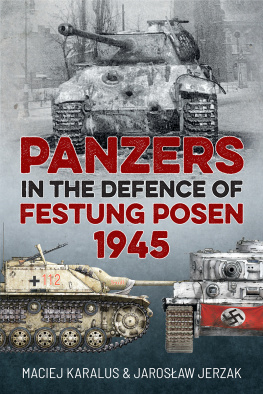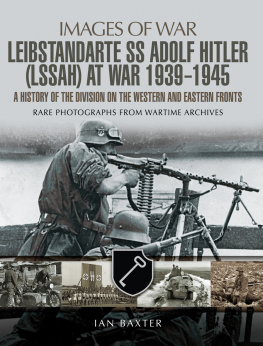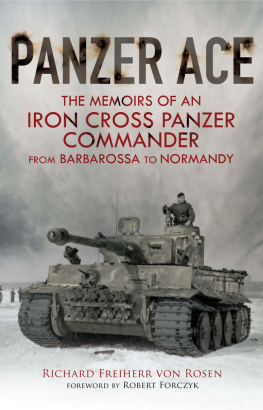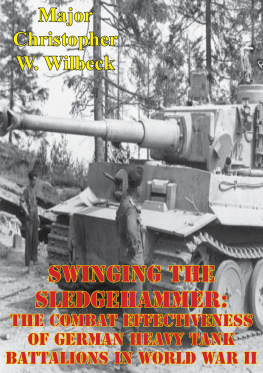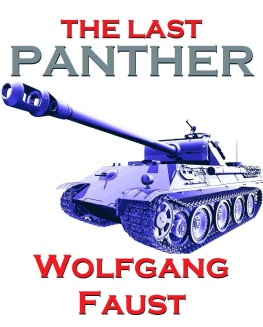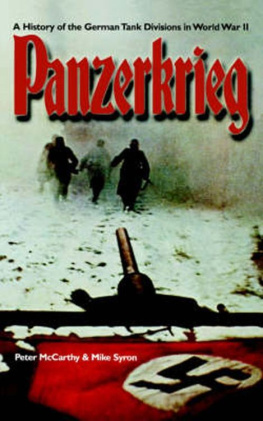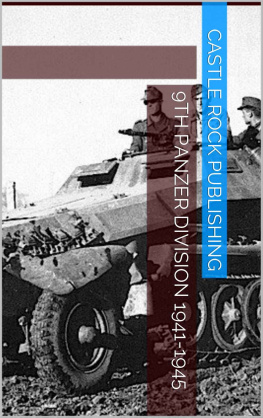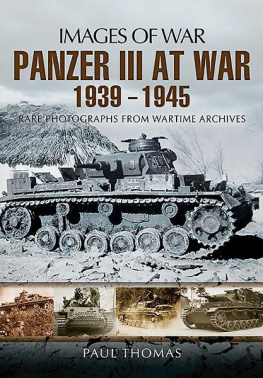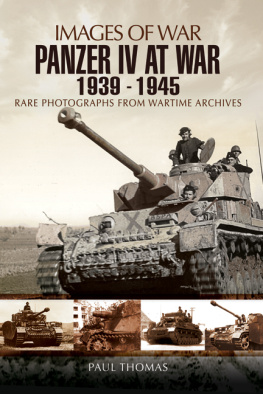Panzers in the Defence of Festung Posen 1945 by Maciej Karalus and Jarosaw Jerzak is the first book published in English to describe the bitter battle for Festung Posen in 1945. That Polish city, occupied by the Nazis since almost the very beginning of the Second World War in 1939, was declared a fortress ( Festung ) on 20 January 1945, and for the whole month it saw heavy fighting between Wehrmacht and Waffen SS troops and the Red Army advancing directly towards Berlin. Among the garrison of the fortress a special part was played by a small heavy Panzer unit which possessed just one Tiger tank, two Panthers, one Panzer IV and a handful of Sturmgeschtze .
Despite the difficulty and sparsity of sources, the authors were able to acquire an impressive wealth of information and memoirs, as well as rich iconography. Before Poland was able to regain her full political autonomy in 1990, the fighting in Pozna was described only by Zbigniew Szumowski and Stanisaw Okcki. These, however, were poor compilations, only marginally touching upon the participation of German Wehrmacht . These authors looked upon this subject through the lenses of Soviet documentations and historiographical propaganda of their times. Sadly, they could not or would not make use of the documents in German archives. Their cardinal mistake was to overestimate the strength of the forces at play (especially on the German side), and the glorification of the Soviet victory, foregoing an honest analysis of the losses of human life as well as equipment on both sides.
This volume allows the reader to follow the street fighting in Pozna through the eyes of the Wehrmacht soldiers, documenting the story of the German armoured forces engaged in the battles for the city.
Maciej Karalus (born 30 May 1974), is a passionate and independent researcher of Second World War history, and particularly of the battle for the Pozna Fortresses in 1945. In 2003, together with Jarosaw Jerzak, he published Pancerna Rezerwa Uderzeniowa Pozna 1945.c [Armoured Assault Reserve Pozna 1945] , which has launched a series devoted to the events in Festung Posen in 1945. The series contributed significantly to the growing interest in the history of the battle for Pozna. Since 2002, he has been an active member of the POMOST (Bridge) Association for the Polish-German reconciliation and publisher of POMOST Publishing House Since 2007.
Jarosaw Jerzak (born 5 April 1956, in Pozna) is a member of the Pozna Fortifications Aficionados Association. He is passionate about the subject of Poznas fortification, specifically armoured warfare and the history of the fighting for Pozna Fortress in 1945. He had served in the armoured forces where he acquired a deep interest in the use of tanks in all theatres of battle in the Second World War. He is the co-author of Pancerna Rezerwa Uderzeniowa [Armoured Assault Reserve] as well as the author of Sowieckie jednostki pancerne w walkach o Pozna [Soviet Armoured Forces in the Battle for Pozna] .
Panzers in the Defence of Festung Posen 1945
Maciej Karalus & Jarosaw Jerzak
Helion & Company Limited
Unit 8 Amherst Business Centre
Budbrooke Road
Warwick
CV34 5WE
England
Tel. 01926 499 619
Fax 0121 711 4075
Email:
Website: www.helion.co.uk
Twitter:
Visit our blog http://blog.helion.co.uk/
Published by Helion & Company 2018
Designed and typeset by Mach 3 Solutions Ltd, Bussage, Gloucestershire
Cover designed by Paul Hewitt, Battlefield Design ( www.battlefield-design.co.uk )
Text Maciej Karalus & Jarosaw Jerzak 2011
Illustrations as individually credited
Maps drawn by George Anderson Helion & Company 2018
English translation in this book Maciej Karalus & Jarosaw Jerzak published with exclusive license by Helion & Company Limited 2018.
Front cover photograph from Russian sources, colour artworks by and Mariusz echtaski.
Every reasonable effort has been made to trace copyright holders and to obtain their permission for the use of copyright material. The author and publisher apologize for any errors or omissions in this work, and would be grateful if notified of any corrections that should be incorporated in future reprints or editions of this book.
ISBN 978-1-912390-16-8
eISBN 978-1-913118-00-6
British Library Cataloguing-in-Publication Data.
A catalogue record for this book is available from the British Library.
All rights reserved. No part of this publication may be reproduced, stored in a retrieval system, or transmitted, in any form, or by any means, electronic, mechanical, photocopying, recording or otherwise, without the express written consent of Helion & Company Limited.
For details of other military history titles published by Helion & Company Limited contact the above address, or visit our website: http://www.helion.co.uk
We always welcome receiving book proposals from prospective authors.
List of Illustrations
Photographs
German tanker posing with his family. The photo was taken in Pozna during the German occupation of the city. (ZP)
Holder of the Knights Cross of the Iron Cross, Major Martin Buhr who was appointed the commander of Sturmgeschtz Ersatz-und Ausbildungs-Abteilung 500 ; previously led by Oberstleutnant Hoffmann-Schnborn for only a few days. He was replaced by Major Fritz Glossner in December 1944. (ZP)
Presentation of Sturmgeschtz Ersatz-und Ausbildungs-Abteilung 500 in front of the Emperors Castle in Pozna, 1944. There are a pair of StuG III Ausf. C assault guns visible in the foreground. (ZP)
StuG III Ausf. F assault guns of the 500th Battalion from Pozna presented during the same event. (ZP)
Unofficial symbol of Sturmgeschtz Ersatz-und Ausbildungs-Abteilung 500 , with a StuG III Ausf. G and the fragment of the Emperors Castle in Pozna ( Posen in German) visible. (ZP)
The initial location of Sturmgeschtz Ersatz-und Ausbildungs-Abteilung 500 s headquarters the Military Court in Pozna at Solna Street (Magazinstrasse), the so-called Treinkaserne. (RJ)
StuG III of Sturmgeschtz Ersatz-und Ausbildungs-Abteilung 500 used as the driver-training vehicle, engined with a Holzgas-Generator. A Polish citizen of Pozna poses inside with a German helmet and part of a Panzerfaust . The photo was taken in the Citadel in 1948. Note the lack of the gun and the large white stripes painted on the front armour. (MB)
Another view of the same vehicle with blind mantlet installation clearly visible. The Citadel of Pozna, 1948. (MB)
The commander of a Sturmgeschtz deployed to the Grodeutschland Division , searching the foreground for the enemy during the fighting on the Eastern Front in 1943 or 1944. (ZP)
StuG III Ausf. G from the 1st Battery of Sturmgeschtz Brigade Grodeutschland during the fighting on the Eastern Front. The commander of this subunit at that time, Knights Cross holder Oberleutnant Diddo Diddens, is visible in the centre. (ZP)
The assault guns transport photographed on Platform 4 of the Main Railway Station in Pozna. A soldier in an assault artillery uniform is visible in the foreground, in addition to the Sturmgeschtze and SdKfz 252 ammunition carriers, hidden with tarpaulins, behind. (ZP)
The Christmas calendar for 1945 prepared by the soldiers of the 1st Battery of Sturmgeschtz Ersatz-und Ausbildungs-Abteilung 500 . (ZP)
Gefreiter Alfred Leupold, born on 24 February 1924, who participated the battle for Pozna as a radio-operator and loader of the Jagdpanzer 38(t) Hetzer tracked tank hunter. (RS)

